Free 71300X Exam Braindumps certification guide Q&A
71300X Certification Overview Latest 71300X PDF Dumps
NEW QUESTION 10
You are creating a SIP Entity for Avaya Aura Engagement Development Platform - EDP / Avaya BreezeTM.
What do you have to enter in the field labeled FQDN or IP Address?
- A. the IP-Address or FQDN of general Purpose Cluster
- B. the Management IP-Address or FQDN of the Avaya BreezeTM platform.
- C. the SM100 IP-address or FQDN of the Avaya BreezeTM platform
- D. the IP-Address or FQDN of Core Platform Cluster
Answer: B
Explanation:
Explanation
Administering an Avaya Breeze instance
Before you begin
To complete this task you will need:
* The IP address of the Avaya Breeze Management Network Interface.
This is the same IP address you used when deploying the Virtual Machine (VM).
* The IP address including the network mask, and default gateway for the Avaya Breeze Security Module.
Procedure (see step 6 below)
1. On System Manager, in Elements, click Avaya Breeze.
2. Click Server Administration.
3. In the Avaya Breeze Server Instances list, click New.
4. In the SIP Entity field, select the SIP Entity that you created.
5. Ensure that the value in the UCID Network Node ID field is unique across the solution deployment so that it does not conflict with other UCID-generating entities like Avaya Aura Communication Manager or Avaya Aura Experience Portal.
6. In the Management Network Interface FQDN or IP Address field, type the IP address of the Avaya Breeze Management Network Interface.
References: Deploying Avaya Breeze, Release 3.1, (September 2016), page 47
https://downloads.avaya.com/css/P8/documents/101014426
NEW QUESTION 11
After the initial provisioning script has been run you see your Avaya Session Border Controller for Enterprise (SBCE) displaying a Registered state in the Web GUI. You click on the install link in the EMS System Management > Devices menu to continue the installation.
After displaying a status of Provisioning for a short while, which status does the SBCE display?
- A. Up
- B. Maintenance-Busy
- C. Busyout
- D. Commissioned
Answer: D
Explanation:
Explanation
SBC states: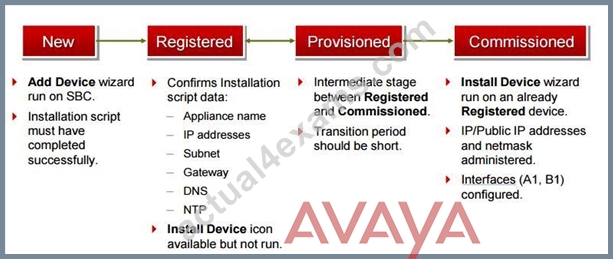
References: Avaya Aura Session Border Controller Enterprise Implementation and Maintenance (2012), page
201
NEW QUESTION 12
The provisioning script automatically runs as part of the first boot-up of the Avaya Session Border Controller for Enterprise (SBCE). During this process you assign the Management IP address to the SBCE. You browse to the Element Management System (EMS) to continue to install the SBCE.
On the System Management > Devices web page, which status does the SBCE display before the Install link is clicked?
- A. Ready
- B. Registered
- C. Commissioned
- D. Provisioned
Answer: B
Explanation:
Explanation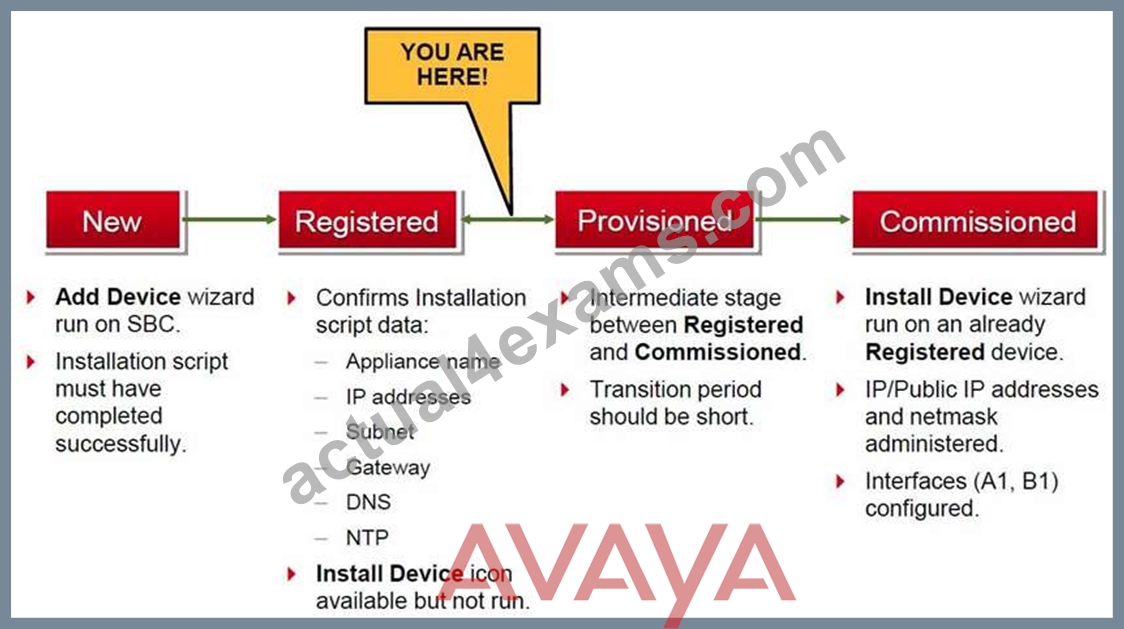
References: Avaya Aura Session Border Controller Enterprise (2012), page 201
NEW QUESTION 13
WebRTC is used for which type of calls?
- A. calls originated from internal and external web browsers
- B. video calls only
- C. calls originated from internal web browsers only
- D. calls originated from external web browsers only
Answer: A
Explanation:
Explanation
The Avaya WebRTC Snap-in enables users inside or outside the Enterprise to make a secure call from their web browser to any endpoint to which Avaya Aura can deliver calls.
References: Avaya WebRTC Snap-in Reference, Release 3.1 (May 2016), page 6
https://downloads.avaya.com/css/P8/documents/101013939
NEW QUESTION 14
On Avaya Session Border Controller for Enterprise (SBCE), where do you access the tool that displays SIP messages, in real time, as they pass through the SBCE?
- A. from Avaya Aura System Manager, navigate to "Session Border Controller for Enterprise > SBCE Administration" menu
- B. from the traceSIP client installed on a local PC
- C. from the SBCE Server command line via SSH session, using PuTTY
- D. from the SBCE EMS Web Console
Answer: C
Explanation:
Explanation
Stat the tue Tracing Tools, TraceSM, SSH to Session Manager
1. Launch PuTTY (or similar client application) for a SSH session to Session Manager (port 22). Use the Session Manager IP Address (172.16.255.107).
2. Log in.
3. At the Session Manager command line type traceSM -x and press Enter.
Note: The traceSM tool shows the SIP call flow in Session Manager.
It gives insight into Session Manager's decisions.
Benefit: can filter certain types of SIP messages
References: Avaya Aura Session Border Controller Enterprise Implementation and Maintenance (2012), page
485
NEW QUESTION 15
In Avaya Aura Messaging (AAM) 6.3, how many Call Answering Ports can one Application Server support?
- A. up to 10 Ports
- B. up to 10000 Ports
- C. up to 1000 Ports
- D. up to 100 Ports
Answer: D
Explanation:
Explanation
The Call Answer Ports range is 2-100.
References: Administering Avaya Aura Messaging, page 34
https://downloads.avaya.com/css/P8/documents/100112131
NEW QUESTION 16
Avaya Aura Presence Services 7.x is implemented on Avaya BreezeTM (formerly known as Engagement Development Platform (EDP)).
When looking at Elements > Engagement Development Platform > Service Management, which status would you expect for a Presence Services snap-in that is ready to support Avaya Aura Presence Services?
- A. Installed
- B. Active
- C. Accepting
- D. Loaded
Answer: C
Explanation:
Explanation
Enabling Avaya Breeze cluster running Presence Services
Before you begin
Ensure that the Avaya BreezeTM servers running the Presence Services are recovered / powered up.
Procedure
1. On the System Manager web console, navigate to Elements > Avaya Breeze > Cluster Administration.
2. Select the Presence Services cluster, and change the Cluster State to Accept New Service.
References: Avaya Aura Presence Services Snap-in Reference. Release 7.0.1 (December 2016), page 48
https://downloads.avaya.com/css/P8/documents/101013646
NEW QUESTION 17
A company is deploying Avaya Session Border Controller for Enterprise (SBCE) to support SIP trunking.
What is the minimum number of IP-addresses they need to assign to the private and public Network Interface Cards (NICs)?
- A. One address is assigned to the private NIC and two addresses are assigned to the public NIC.
- B. Two addresses are assigned to the private NIC and two addresses are assigned to the public NIC.
- C. Two addresses are assigned to the private NIC and one address is assigned to the public NIC.
- D. One address is assigned to the private NIC and one address is assigned to the public NIC.
Answer: D
Explanation:
Explanation
Example configuration: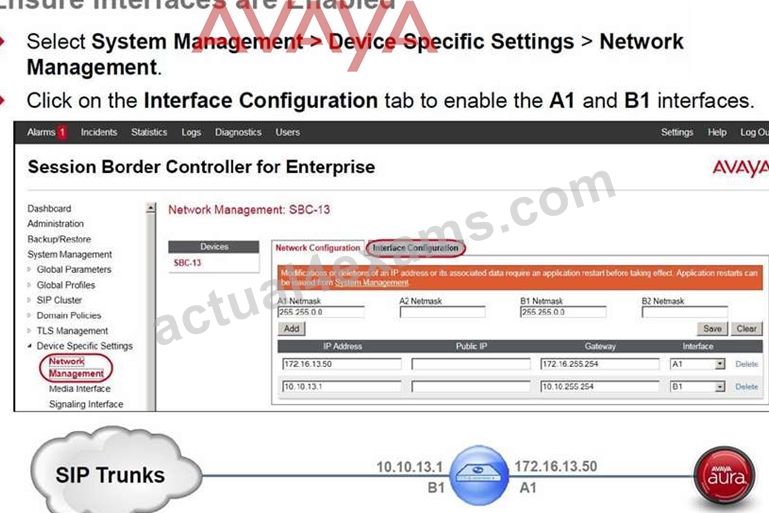
References: Avaya Aura Session Border Controller Enterprise Implementation and Maintenance (2012), page
305
NEW QUESTION 18
You want to multiplex all remote workers SIP messages to Avaya Aura Session Manager (SM) over the same TCP connection, rather than open a dedicated TCP connection for each user.
Which feature needs to be enabled for Avaya Session Border Controller for Enterprise (SBCE)?
- A. the Enable Shared Control feature in the Signaling Interface.
- B. the Stream Users Over Transport Link feature in the Signaling Interface
- C. the Share Transport Link feature in the Advanced tab of the Avaya Aura Session Manager (SM) Server Profile
- D. the Enable Grooming feature in the Advanced tab of the Avaya Aura Session Manager (SM) Server Profile
Answer: D
Explanation:
Explanation
Example: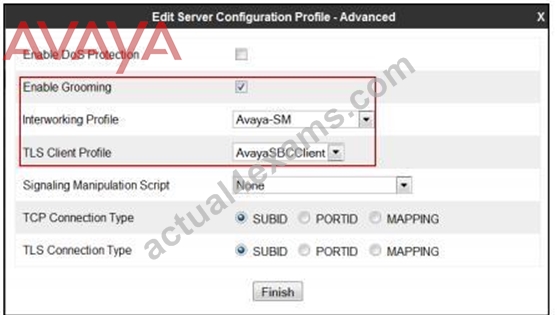
References: Configuring Remote Workers with Avaya Session Border Controller for Enterprise Rel. 6.2, Avaya Aura Communication Manager Rel. 6.3 and Avaya Aura Session Managers Rel. 6.3 - Issue 1.0, page 36
https://downloads.avaya.com/css/P8/documents/100183254
NEW QUESTION 19
The media stream in WebRTC is anchored on which Avaya Aura component?
- A. Avaya Aura Media Server (AAMS)
- B. No DSP Resources are required
- C. Avaya Aura Media Gateway G430/G450
- D. G650 Medpro
Answer: A
Explanation:
Explanation
The Avaya WebRTC Snap-in enables users inside or outside the Enterprise to make a secure call from their web browser to any endpoint to which Avaya Aura can deliver calls.
The WebRTC Snap-in supports 1800 simultaneous calls at a rate of 28,000 BHCC in the following deployment model:
1 Avaya Breeze server
1 Avaya Session Border Controller for Enterprise (Avaya SBCE) server
8 Avaya Aura Media Servers
References: Avaya WebRTC Snap-in Reference, Release 3.1 (May 2016), page 26
https://downloads.avaya.com/css/P8/documents/101013939
NEW QUESTION 20
When Avaya Aura Presence Services is implemented, which statement is true about Port Management?
- A. It allows independent management capabilities to filter out undesired message to every Avaya Aura Presence Services user.
- B. It collects statistics about Port-Usage from each Presence-compatible endpoint across the network.
- C. It allows multi-media services over a standard Web-Browser.
- D. Port 5222 is used for one-X Endpoints, while Port 5269 is open for connecting with other XMPP
3rd-Party Servers.
Answer: D
Explanation:
Explanation
Port 5222: XMPP connection configuration
The Connection Manager runs by default when you install the XCP server. It is configured with a JSM Command Processor and two XMPP directors. The XMPP directors handle communication with IM clients.
One of the directors is configured to use port 5222 and the other is configured to use port 5223 for secure communications.
Port 5269:Example Obtaining the Server-to-Server Port from an Openfire server Procedure
1. Log in to the Openfire Web console.
2. Click Server > Server Settings > Server to Server.
3. In the Service Enabled section, the Enabled check box should be checked, and the port value is contained in the box to the right of Remote servers can exchange packets with this server on port.
By default the value is 5269, and it is recommended that this default value be maintained.
References: Administering Avaya Aura Presence Services, Release 6.2.4, (June 2014), pages 110, 154
https://downloads.avaya.com/css/P8/documents/100180467
NEW QUESTION 21
In Avaya Session Border Controller for Enterprise (SBCE) 7.x, which two configuration screens must be configured for Personal Profile Management (PPM) to be successfully downloaded to an Avaya SIP Telephone (AST)? (Choose two.)
- A. File Transfer
- B. PPM Services Mapping Profile
- C. Reverse Proxy
- D. Application Relay
Answer: B,D
Explanation:
Explanation
B: Application relays function as port forwards. Different clients require different application relays.
A: An Avaya SIP phone downloads and processes a configuration file, sends out a slew of SUBSCRIBE messages, and uses something called Personal Profile Manager (PPM).
Note: The PPM is a software module that runs as part of an Avaya Session Manager. It consists of a series of web services that phones use to retrieve and manage SIP related user data.
References:
https://andrewjprokop.wordpress.com/2014/03/28/understanding-avayas-personal-profile-manager-ppm/
https://downloads.avaya.com/css/P8/documents/101028355
NEW QUESTION 22
Which three functionalities does WebRTC provide? (Choose three.)
- A. NAT / Firewall Traversal
- B. real-time audio and video conferencing
- C. adds click-to-call capabilities from a web application to an Avaya endpoint
- D. Internet-friendly codecs and Privacy
Answer: A,B,C
Explanation:
Explanation
* One of the primary differentiating features for the WebRTC Snap-in is that the web application handles authentication and authorization of calls. This includes the capability to assert a calling user's phone number and restrict the numbers that can be called.
* The Avaya SBCE enables secure firewall traversal for HTTP and SRTP packets, facilitates sending DTLS to provide secured key exchange for the SRTP flow, and takes care of all security requirements mentioned in the TURN protocol for the solution.
* WebRTC can be a game changer for enterprise communications and customer engagement. Enterprises can now add real-time communications to any website.
References: Avaya WebRTC Snap-in Reference, Release 3.1 (May 2016), page 9
https://downloads.avaya.com/css/P8/documents/101013939
NEW QUESTION 23
In Avaya Session Border Controller for Enterprise (SBCE), what is the default state of an Interface?
- A. Deployed
- B. Active
- C. Disabled
- D. Enabled
Answer: C
Explanation:
Explanation
Example:
Commission the SBC-SBC Configuration
1. The A1 and B1 interfaces display on the Network Configuration tab.
2. Click on the Interface Configuration tab: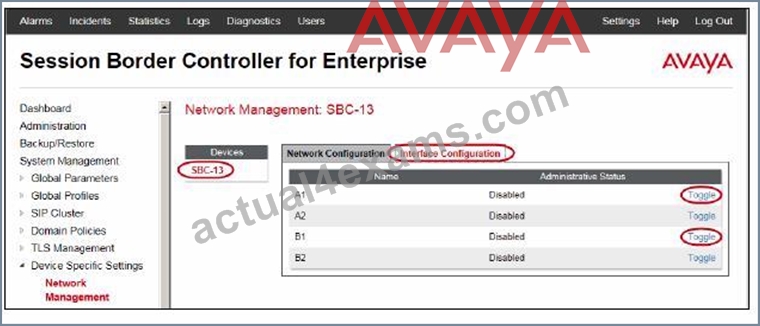
3. Click the Toggle link for both the A1 and the B1 interfaces.
The Administrative Status for both A1 and B1 changes to Enabled:
References: Avaya Aura Session Border Controller Enterprise Implementation and Maintenance (2012), page
203
NEW QUESTION 24
Before SIP Trunking configuration can begin, which state must the Avaya Session Border Controller for Enterprise (SBCE) be in?
- A. Ready
- B. Provisioned
- C. Registered
- D. Commissioned
Answer: D
Explanation:
Explanation
Prerequisite Conditions for SIP Trunking
Starting point for SIP-trunking administration:
System Management > Installed tab shows SBC(s) Commissioned indicates a successful initial console configuration.
References: Avaya Aura Session Border Controller Enterprise Implementation and Maintenance (2012), page
302
NEW QUESTION 25
In which location is the AAMS URI '[email protected]' configured?
- A. Home > Elements > Breeze > Configuration > Avaya Aura Media Server and as a Dial Pattern
- B. Home > Elements > Breeze > Configuration > Avaya Aura Media Server and as a Regular Expression
- C. Elements > Breeze > Configuration > HTTP Security and as a Regular Expression
- D. Elements > Breeze > Configuration > HTTP Security and as a Dial Pattern
Answer: B
Explanation:
Explanation
Creating the Avaya Aura Media Server Routing Pattern
Procedure
1. On System Manager, click Elements > Routing > Routing Policies.
2. Click New.
3. Type a Name for the Routing Policy.
4. From the SIP Entity as Destination field, click Select.
5. Select the Avaya Aura
Media Server SIP Entity that you created.
Select the Local Host Name FQDN SIP Entity if you are using High Availability for the Avaya Aura Media Server routing.
6. Click Commit.
7. Navigate to Home > Elements > Routing > Regular Expressions and click New.
8. In the Pattern field, type ce-msml@<sip-domain>.*
This sip-domain value must match:
* The SIP domain that you entered in the Home > Elements > Routing > Domains page.
* The default SIP domain that you entered on the Avaya BreezeTM Cluster Administration page.
9. Click Commit
https://downloads.avaya.com/css/P8/documents/101014426
References: Deploying Avaya Breeze, Release 3.1, (September 2016), page 55
NEW QUESTION 26
If more than one Avaya BreezeTM node is available in the cluster, which statement about redundancy and load-balancing is true?
- A. The Cluster IP address is not used for Presence Services in 7.0. IM clients configure a FQDN instead of IP address which is resolved by a DNS server to all Avaya BreezeTM nodes in the cluster.
- B. IM clients point to any Avaya BreezeTM node SM100 IP address. The client is dynamically informed of alternate Avaya BreezeTM nodes in the cluster.
- C. The list of all Avaya BreezeTM nodes SM100 IP addresses must be configured in the client.
- D. IM clients point to the Leader Avaya BreezeTM node SM100 IP address which redirects the clients to a particular Avaya BreezeTM node based on load-balancing policy.
Answer: D
Explanation:
Explanation
Enable load balancing for a cluster if you want to scale the HTTP services without targeting a particular Avaya BreezeTM server. All the requests are sent to the cluster IP address. When you enable load balancing, two Avaya BreezeTM servers are chosen as the active and standby load balancing servers. The active load balancer distributes the HTTP requests to all the other servers in the cluster in a round robin fashion.
References: Administering Avaya Breeze, Release 3.1 (May 2016), page 16
https://downloads.avaya.com/css/P8/documents/101014143
NEW QUESTION 27
What identifies that the Avaya BreezeTM server is using Identity Certificates that have been signed by Avaya Aura System Manager (SMGR)?
- A. if the Entity Link between Avaya Aura Session Manager (SM) and Avaya BreezeTM server is up
- B. if the replication status is showing 'Synchronized' with a green background color
- C. if a successfully installed WebRTC snap-in is used
- D. if the Issuer Name states "O=AVAYA, OU=MGMT, CN= System Manager CA" for the Security Module SIP Identity Certificate
Answer: D
NEW QUESTION 28
To allow trust between Avaya Aura System Manager (SMGR) and Avaya Aura Messaging (AAM), there is a password set when you add the Trusted Server on AAM. This password must match with the password also configured in SMGR.
Which statement about the password in SMGR is true?
- A. It needs to match the Attributes of the Messaging Managed Element in the Inventory.
- B. It needs to match the admin password used to login to SMGR using a web browser.
- C. It needs to match the root password used to login to SMGR command line.
- D. It needs to match the Enrollment Password.
Answer: A
Explanation:
Explanation
Configuring Messaging in the normal operational mode
Before you begin
* Add both the primary and secondary servers as Trusted Servers in the Messaging system.
* Update the Login, Password, and Confirm Password fields with the appropriate trusted server defined on the Messaging system.
Procedure
1. Log on to the Messaging system that System Manager manages.2. Add the secondary System Manager server as Trusted Servers in the Messaging system.
3. Log on to the secondary System Manager server.
4. On the System Manager web console, click Services > Inventory.
5. In the left navigation pane, click Manage Elements.
6. On the Manage Elements page, select the Messaging system that you want to change to the secondary System Manager server.
7. Click Edit.
8. On the Attributes tab, fill the Login, Password, and Confirm Password fields with the corresponding name and password of the Messaging trusted server.
9. Click Commit.
10. Click Inventory > Synchronization > Messaging System, and select the required Messaging element.
11. Click Now.
The secondary System Manager server retrieves all data from Messaging and is now ready to administer and manage Messaging.
References: Administering Avaya Aura System Manager for Release 6.3.11 and later, Release 6.3, Issue 8 (November 2016), page 104
https://downloads.avaya.com/css/P8/documents/101008185
NEW QUESTION 29
What are the three components of Avaya Aura Messaging (AAM)? (Choose three.)
- A. AxC/Directory
- B. SM100 Module
- C. Application Server
- D. Messaging Store
- E. Messaging Distributor
Answer: A,C,D
Explanation:
Explanation
The AXC connector is always co-resident with the Avaya message store.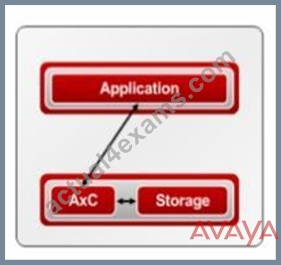
References: Administering Avaya Aura Messaging Release 6.2, Issue 2.2 (December 2013)
https://downloads.avaya.com/css/P8/documents/100172127
NEW QUESTION 30
A field engineer runs the Installation Wizard to install the Avaya Session Border Controller for Enterprise (SBCE).
Which statement about the Domain Name Service (DNS) configuration is true?
- A. A DNS address does not need to be configured.
- B. A DNS address always needs to be configured for both the Primary and Secondary DNS, even if only the DNS is available.
- C. A DNS address should not be configured here.
- D. A DNS address needs to be configured, even if it is unused and/or unreachable.
Answer: D
Explanation:
Explanation
The system requires the DNS server to resolve the host names for alarming and remote access name associated with the Avaya Service Center.You must supply a DNS address entry, even if it is unused and/or unreachable.
NEW QUESTION 31
You are starting the process to create a server certificate so it can be installed in the Avaya Session Border Controller (SBC).
What must be done before creating a server certificate for SBC?
- A. Generate a Certificate Signing Request (CSR) in SBC.
- B. Run initTM -d from SBC CLI.
- C. Add End Entity in Session Manager.
- D. Download a CA PEM file from System Manager.
Answer: A
NEW QUESTION 32
......
Avaya 71300X Exam Syllabus Topics:
| Topic | Details |
|---|---|
| Topic 1 |
|
| Topic 2 |
|
| Topic 3 |
|
| Topic 4 |
|
| Topic 5 |
|
| Topic 6 |
|
| Topic 7 |
|
| Topic 9 |
|
The Best Avaya 71300X Study Guides and Dumps of 2021: https://www.actual4exams.com/71300X-valid-dump.html

